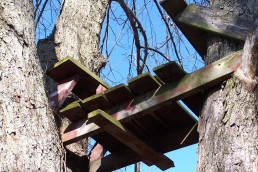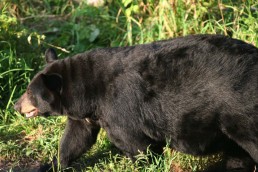Summer Project: Soundproof your Treestands
SHARE THIS POST
Thoughts of my first treestand quickly come to mind each time I set foot in the woods and attach all my stands prior to archery season. In the fall of 1990, I remember asking my dad if we could build a ladder stand out of wood a month before my first archery season in Michigan. Not much notice, but at age 12 I was so eager to head afield with bow in hand that thoughts of building a stand totally slipped my mind.
Within a couple of hours, my dad and I had finished the stand, which stood about 10 feet and consisted of a ladder made of two-by-fours and a small sheet of plywood for the platform. Back then there weren’t many treestand manufactures to choose from like now, so I had to make do with this wooden one.
A few archery seasons later, I finally had a shot opportunity on a 4-point buck that came into shooting range. A well-placed shot sent the deer crashing through saplings and through the golden rods in front of me. Not understanding the importance of giving the deer some time before tracking, I decided after only five minutes that it was time to get down and begin looking for blood. As I stood up, I accidentally bumped the 5-gallon pail, which I had used as a seat. The noise startled the buck, which to my surprise had bedded down only 30 yards away, causing it to flee. Unfortunately, my dad and I never did recover the buck, even though we had good blood.
This particular hunt had an impact on me. To this day it made me realize the importance of making sure that all of my treestands are inspected prior to the season for detections of any type of noise (including considering nailing a piece of carpet to the platform. After all, there is nothing worse than having your entire hunt ruined because of a little noise that came from somewhere in the trees. Although the days of permanent and homemade treestands have faded, new ones can still make some type of noise out of the box.
With that said, here are some tips to help prevent any unwanted noise from ruining your bowhunt.
Hearing
A lot of attention has been given to the extraordinary sense of smell whitetails have. We hunt according to the wind, wear scent-eliminating clothing and spray our clothing and our gear down. However, a deer’s hearing should not be a sense that goes unnoticed. Although their hearing is good, deer live and breathe in areas we hunt, so foreign noises such as a bow clanging against the treestand or a creaking noise from our seat can cause a whitetail to run for cover. Unfortunately, I’ve found this out the hard way.
A whitetail’s large, cupped ears allow it to amplify sound coming from longer distances. They also have the ability to rotate their ears independently, allowing them to pinpoint the direction noises are coming from. However, rain, thick cover and topography can negatively affect the quality of their hearing.
Stand inspection
Removing all my treestands from the deer woods isn’t one of my favorite things; it means that bowhunting season has come to an end. However, in order to maintain the integrity of the treestand and to prevent stand noise in the future, an inspection is necessary. Nuts and bolts may loosen, or rust and sunlight may cause the straps securing the stand to deteriorate, and wildlife may chew at them. I’ve had several instances where squirrels have chewed at and completely destroyed my strap-on seat cushions during the archery deer season.
Are you enjoying this post?
You can be among the first to get the latest info on where to go, what to use and how to use it!
Another danger to your treestand is tree growth. This natural occurrence will cause the stand to shift and may weaken its cables, nuts and bolts, compromising your safety. I’ve also seen trees that had screw-in steps placed in them where the tree had grown and they started expanding around the steps. Most treestand manufacturers recommend not leaving your stands up for extended periods of time due to the stresses placed on them from these types of things. The creaking noise that they may produce due to rust and the impact of the growing tree on the stand is something all bowhunters fear when standing up on their stands and are coming to full draw.
Rubber spray paint
Tired of battling with a particularly noisy ladder stand this past season that creaked every time I reached about the halfway point, I decided to spray on a coat of Rust-Oleum Rubberized Undercoating to it. My only regret is not doing this when I first purchased the stand nine years ago. Had I taken the time to do this, I probably would’ve filled more tags and have avoided the heartache of numerous hunts without seeing a single deer. Applying some type of rubberized paint to your treestands is one of the best steps you can take to dampen noise during a hunt or while setting up or taking down a stand. This rubber application also acts as a protective barrier against rust, which can form on the stand’s nuts, bolts or main frame.
Pipe insulation
Foam pipe insulation can also be used to pad the shooting rests or the armrests on a treestand. This product already comes with a slit in it, which allows you to easily place this around the metal bars. I added these to the armrests on my ladder stand, and they were a great fit. In order to prevent them from sliding, I took some 8-inch zip ties and placed them around the foam insulation on both ends. Duct tape can also be used in place of zip ties. And if you have a few spare pool noodles lying around the house, these can also be used in place of pipe insulation. These multi-colored pool toys can be spray painted to camouflage them if needed.
Felt and weather strip
Besides using pipe insulation, you can add felt or weather stripping to the rails or tubular supports of your treestand to soundproof them and absorb vibration. Both of these materials are available in weatherproof material and have a peel-n-stick design for easy application. Another alternative to these is rubberized non-slip tape, which could be a great addition on the steps of a ladder stand or on portions of the platform. These materials are considered “all-weather,” and will resist any of the elements that come within a deer season.
Haul line
Maybe some of you already do this, but here’s an easy tip that will prevent your gun or bow from making noise when raising and lowering them while up in your stand. Take a thin UV/rot-resistant rope and cut it short enough so that the gun or bow suspends freely without touching the ground. As long as either of these stops just shy of the ground (could be 1 or 2 inches), it’s fine. A karabiner can also be attached to the lower end to make attaching or detaching easier. If you’d rather not have either of these dangling in the air, there is an alternative. Simply remove leaves, sticks and other debris from where your gun or bow will touch the ground.
Although on occasion I sometimes end up with unfilled tags in my pocket, this doesn’t necessarily mean that the season was a failure. Every time I set foot in the woods I come back with invaluable knowledge that will help me improve, whether it’s my woodsman skills or my equipment. I have found that soundproofing your stands is one more step we can take as bowhunters to increase our chances of harvesting a mature whitetail. After all, paying attention to the details is the name of the game for bowhunting.
I only wish that I had taken these steps 27 seasons ago when I was 10 feet up sitting on that wooden platform.
Did you enjoy this post?
You can be among the first to get the latest info on where to go, what to use and how to use it!
Darin Potter
Darin Potter’s passion for outdoor writing began at the age of 12 when he first began writing in a journal that his parents bought him on a family camping trip in Northern Michigan. His writings have appeared in several Midwest publications: Michigan-Out-of-Doors, Michigan and Ohio Outdoor News, Modern Pioneer, and MidWest Outdoors.

